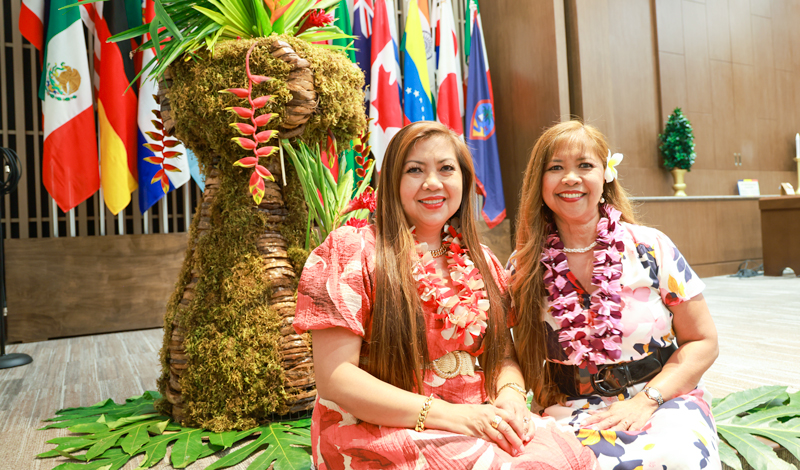by Kathy Alegria
Tamuning, Guam
World Tribune: Thank you, Kathy, for speaking with us today. You left Guam at 18 for college in Cupertino, California, with your mother’s blessing. But her blessing came with one condition—that you not follow in your sister’s footsteps.
Kathy Alegria: “Otherwise, I won’t let you go.” I remember her words exactly.
WT: Tell us about that.
Kathy: It was simple, really. My older sister, who’d left three years earlier for college in Cupertino, had left Guam a devout Catholic and come back a practicing Buddhist. Conversion was one thing, but even more taboo was the simple fact of her disobedience. What struck me was her spirit—she’d come back kinder, happier than I’d ever known her. What’s more, when my parents threatened to cut off her tuition, she’d said so be it and they cut it off. She returned to college and found work to pay her own way. Her boldness and courage, so uncharacteristic of the sister I’d known, left a lasting impression on me.
In any case, I wasn’t risking a perpetual grounding on account of religion. I was getting out of Guam, with its two roads and everyone I knew and who knew me (a smaller, more secluded island in the ’80s than it is today). Choosing my words with care, I told my mother she had nothing to worry about.
In any case, I packed my bags for Cupertino and didn’t think of Buddhism until my sister mentioned it, by which point I wanted to try whatever it was she was doing. I needed every ounce of courage to face the day.
WT: Life was that different?
Kathy: It was that different. The mainland was larger, the traffic faster, the days longer. I’d known everyone in Guam, and now I knew hardly anyone. I began chanting, attending SGI activities and studying Ikeda Sensei’s encouragement and Nichiren Daishonin’s writings.
My mother paid a visit at the end of the school year for my sister’s graduation, but also, I think, to check on me. I didn’t hide my altar, set up in my room. She took one look and went berserk.
WT: What happened?
Kathy: Both my sister and I were cut off financially and had to rely on each other to pay our way through college. I returned home to pursue nursing school, taking my Buddhist practice with me.
Over the years, my parents saw me graduate from nursing school, marry Conrad, the man of my dreams, and raise two spoiled—I mean, wonderful—children, Matthew and Lauren. Conrad’s dental business, the largest on the island, has allowed me the freedom to work energetically for kosen-rufu and the members in Guam.
My parents were stoic people, and showed their acceptance in subtle ways. Ultimately, both accepted our faith and embraced us. What is more important than family, in the end? Supporting each person fully, without conditions is, after all, what families should do.
WT: We understand that, two years ago, Marianas Region launched a propagation campaign toward the SGI’s 50th anniversary, which we just celebrated in January. Your team pledged to discuss Buddhism with 25,000 people, roughly 15% of the population. You must have known it would be a vigorous struggle. What was the spirit behind it?
Kathy: Struggle, I think, is the right word. Guam has historically been a peaceful place, its culture rooted in the CHamoru values of interdependence and mutual respect. But peace was shattered during World War II, when the U.S. and Japanese militaries turned Guam into a battlefield.
WT: Guam was prized by both for its strategic military potential.
Kathy: You can imagine how fiercely it was fought over. Caught between the great powers, the peace-loving people of Guam were defenseless. We were determined, toward the 50th anniversary of SGI’s founding, to wage a struggle for peace.
WT: How were you received?
Kathy: Some just nodded politely at us, but others really listened. Others still, took a World Tribune with a shrug, and then showed up later with all kinds of questions, having read it front to back.
WT: You made this goal of planting seeds, but then, just as soon as you were picking up steam, a typhoon hit the island, in late May.
Kathy: And not just any typhoon—a super typhoon, Typhoon Mawar, the strongest to strike in over 20 years. Powerful winds howled all night, and no one in Guam slept much. The following day, I peered outside the door and found a mess—shrubs laid bare and trees toppled. Snapped powerlines hanging in the branches.
I went inside for gongyo, praying for the safety of the members. Soon, I gathered with the region team at the center, which was in good condition. We started with outreach, planning visits with whoever we could get ahold of. The streets were drivable and we took them slowly, careful around debris and through the unlit intersections. One by one, every member was accounted for. When we relaunched our propagation campaign, it was with greater numbers and passion.
Months out from the 50th anniversary, we hit our goal of 25,000 seeds. We then redoubled our efforts, wanting to see by how large a margin we could surpass it.
WT: Wonderful. Kathy, another big celebration took place last year, six months out from the SGI’s 50th anniversary. Tell us about it.
Kathy: The memory of the war runs deep. Its lessons are passed down in our schools, public works, stories and songs. One event in particular gathers the whole island—the Liberation Day Parade. Last July marked the 80th anniversary of Guam’s liberation from Japanese rule, so, as you can imagine, the parade was humongous. We had taken part before, but this time was different. Fresh from the storm, we determined to use this occasion to cultivate the peace of the land. That day alone, we introduced 6,000 people to Nam-myoho-renge-kyo.
WT: Incredible! What kind of movement do you want to create in Guam?
Kathy: The kind that Sensei began and that we’re expanding now. The words of one young woman say it all. Her mother relayed them to me a month after Mawar, when cell service had returned to the island. She called to tell me what her daughter had said through tears the day we’d visited their home, which, unlike the trees around it, was still standing.
“They came just to see that we were OK,” she’d said. “That’s what family would do.”
You are reading {{ meterCount }} of {{ meterMax }} free premium articles

